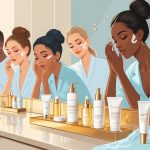Best Place to Buy SPF Foundations Just Revealed by Beauty Insiders
SPF Foundation Myths, Mistakes, and Insider Advice
I still cringe thinking about the time I got sunburned at a company picnic, thinking my “SPF 30 foundation” had me covered. Nope. I packed all the wrong confidence and zero real sunscreen, assuming my makeup would save me. Spoiler: it didn’t, and my nose was a mess for days.
There are so many traps in the SPF foundation world—marketing, application, and those sneaky gaps in your routine.
Common Misconceptions About SPF Coverage
Way too many people (including me, once upon a time) think if “SPF” is on the bottle, you’re good. Not really. Brands like IT Cosmetics and bareMinerals slap SPF on their labels, and it’s easy to trust you’re set for the whole day. But if you’re only using a thin layer of tinted moisturizer or foundation, that “SPF 30” is probably more like SPF 7 or 8 in the real world.
Derms and beauty insiders keep saying it: SPF in foundation isn’t a replacement for real broad-spectrum sunscreen. It’s better than nothing, but it’s not your main protection. Foundations with SPF aren’t meant to be slathered on like sunscreen, so you never get full coverage.
For actual UV protection, you need a real face sunscreen underneath. I used to think one step could do it all, but nope—layering is key.
Avoiding Application Errors
Even with the fanciest SPF foundation (yeah, I’m looking at you, Estée Lauder Futurist or Supergoop! CC Screen), it’s ridiculously easy to screw up and lose that promised protection. Most of us use a tiny, pea-sized blob for our whole face—no surprise, that’s just not enough to get the SPF rating they brag about on the bottle.
Here’s what I do now: I use a full pump, sometimes more, and I force myself not to skip weird spots like my jawline, hairline, or the sides of my nose. I even started setting timers to remind myself to reapply if I’m out in the sun, which felt totally over the top…until I noticed less sun damage.
If you’re like me and love mixing SPF foundation with other stuff—maybe moisturizer or a dewy setting spray—just be careful. Mixing can water down the sunscreen’s power. I get better results when I slap it straight onto clean, dry skin. Dermatologists have plenty to say about these little SPF myths and mistakes, if you’re curious: read more here.
When to Layer with Face Sunscreen
Almost every beauty insider I trust (including my own esthetician, who’s seen my face way too close up) swears by layering. That means standalone face sunscreen first, then SPF foundation on top. If I’m outside for a while—or just trapped in the car with sunlight blasting through the window—I double up. It sounds like a chore, but honestly, the results are hard to argue with.
I usually reach for La Roche-Posay Anthelios Fluid, let it dry, then go in with my favorite SPF foundation. I end up with a strong base layer of UV protection and a finish that actually looks like my skin, not a mask.
People keep telling me this combo helps with fine lines and pigmentation, and honestly, I’ve noticed fewer weird sun spots popping up. It just fits into my routine now, no drama. There’s more on this in any solid skincare routine guide.
If you want your makeup to last and look good, try foundations made for layering—like Shiseido Synchro Skin Self-Refreshing Foundation SPF 30. No clogging, no weird streaks, no guessing games. I messed this up plenty before it became second nature.
Frequently Asked Questions
For ages, I thought SPF foundation was just another marketing scam. Then I went to a summer wedding—half my face got tanned, except the spots caked in my SPF 50 foundation. Some brands really do save your skin, but not all SPF claims are worth trusting.
The real trick is figuring out which foundations actually block both UVA and UVB, which ones won’t turn my oily skin into a slip ‘n slide, and what works for skin that’s, well, not fresh out of high school.
What are the top sunscreen foundations with SPF 50 recommended by beauty experts?
I can’t count how many times I’ve forgotten regular sunscreen and just leaned on my IT Cosmetics CC+ Cream SPF 50. My skin still looked pretty solid at the end of the day. Beauty insiders keep hyping this one, along with Shiseido Synchro Skin Self-Refreshing Foundation SPF 50 and La Roche-Posay Anthelios Mineral Tinted SPF 50. They’ve got real UVA and UVB coverage and don’t melt off by mid-afternoon.
Supergoop! CC Screen SPF 50 is another one I reach for—a legit foundation that happens to be a sunscreen, not the other way around.
Which foundations offer the best SPF 50 protection for mature skin?
I’m always patting in foundation, hoping it won’t settle into lines by noon. SPF 50 makes it trickier. Lancôme Rénergie Lift Makeup SPF 27 gets tossed around a lot, but for true SPF 50, It Cosmetics CC+ Cream (again, sorry for repeating, but it’s just good) and L’Oréal Age Perfect Radiant Serum Foundation SPF 50 come up most from folks with more mature skin. They don’t leave that weird chalky cast and actually sit nicely on skin that’s seen a few decades.
What are the best foundations with sunscreen for oily skin types?
Honestly, my T-zone could power a small lamp. If I’m not careful, foundation over SPF just slides right off. Dermatologists always tell me to stick to oil-free stuff. I’ve had the best luck with Estée Lauder Double Wear Sheer Long-Wear SPF 19 and Shiseido Synchro Skin Self-Refreshing Foundation SPF 50. The matte finish helps keep things under control, and I avoid super creamy formulas—they just break down and make everything worse.
What are the top full-coverage, natural-looking foundations with SPF?
“Full-coverage” used to make me think of theater makeup, but I’ve changed my mind. Some, like Lancôme Teint Idole Ultra Wear Foundation SPF 35 and Fenty Beauty Pro Filt’r Soft Matte Longwear SPF 30, actually look like skin if you blend them in right. Maybelline’s Dream Urban Cover SPF 50 surprised me—solid coverage without that heavy, suffocating feel. I’ve found shade matching is half the battle, and I always use a damp sponge instead of a brush.
Which SPF 30 foundations provide the best value and protection?
I’m a sucker for a bargain at checkout. Drugstore picks like L’Oréal Infallible 24 Hour Fresh Wear Foundation SPF 30 and Maybelline Fit Me Dewy + Smooth SPF 18 (okay, not quite SPF 30, but close enough for me most days) get a lot of love for being affordable and easy to find. Sure, pricier brands have bells and whistles, but sometimes I just want basic broad-spectrum protection and coverage that doesn’t cost a fortune.
What are the best beauty insider tips for choosing a foundation with sufficient sunscreen?
Dermatologists won’t stop reminding me—using a separate sunscreen under foundation is the way to go. Honestly, I get it, because who actually slathers on enough foundation to hit the SPF number on the bottle? Not me.
If you want real protection (like, not just pretending), I always look for something that says broad-spectrum and has at least SPF 30. That’s kind of my bare minimum, even if I sometimes wish I could get away with less.
I pay attention to undertones and what kind of finish I’m in the mood for. Oh, and if I want my skin to actually be protected? I have to remind myself—go heavier, blend it evenly, no shortcuts. Otherwise, what’s the point?



